The Intel 6th Gen Skylake Review: Core i7-6700K and i5-6600K Tested
by Ian Cutress on August 5, 2015 8:00 AM ESTWhat You Can Buy: Windows Professional Performance
Agisoft Photoscan – 2D to 3D Image Manipulation: link
Agisoft Photoscan creates 3D models from 2D images, a process which is very computationally expensive. The algorithm is split into four distinct phases, and different phases of the model reconstruction require either fast memory, fast IPC, more cores, or even OpenCL compute devices to hand. Agisoft supplied us with a special version of the software to script the process, where we take 50 images of a stately home and convert it into a medium quality model. This benchmark typically takes around 15-20 minutes on a high end PC on the CPU alone, with GPUs reducing the time.
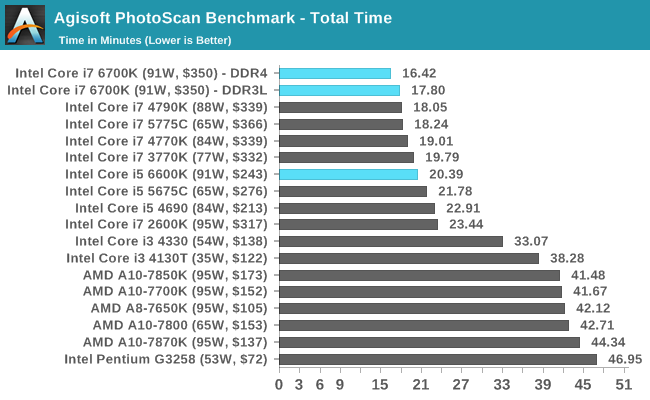
Cinebench R15
Cinebench is a benchmark based around Cinema 4D, and is fairly well known among enthusiasts for stressing the CPU for a provided workload. Results are given as a score, where higher is better.
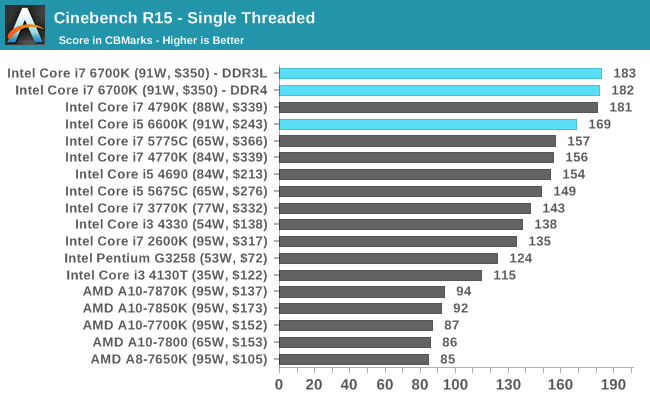
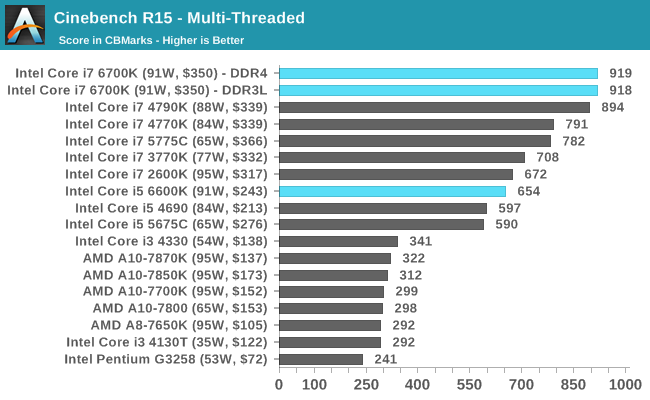
HandBrake v0.9.9: link
For HandBrake, we take two videos (a 2h20 640x266 DVD rip and a 10min double UHD 3840x4320 animation short) and convert them to x264 format in an MP4 container. Results are given in terms of the frames per second processed, and HandBrake uses as many threads as possible.
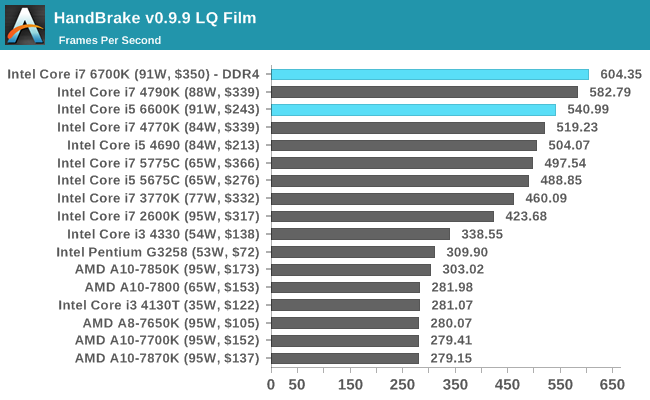
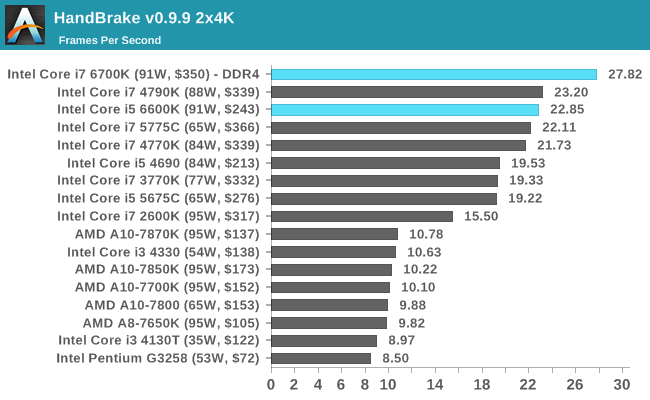
Hybrid x265
Hybrid is a new benchmark, where we take a 4K 1500 frame video and convert it into an x265 format without audio. Results are given in frames per second.
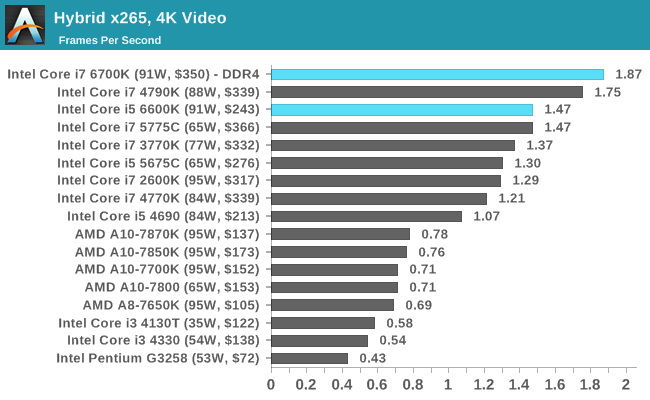










477 Comments
View All Comments
xxxGODxxx - Saturday, October 31, 2015 - link
Hi guys I would like to know whether I should buy the 6600k with a z170 mobo at $417 or should I buy a 3930k with a x79 mobo at $330? I'm not too sure if the extra IPC of the 6600k is enough to warrant the extra $87 over the 3930k especially since I will be overclocking the cpu and I will be gaming on a r9 390 (maybe I will add one more 390 in the future) at 1440p.Toyevo - Wednesday, November 25, 2015 - link
Even now I hesitate at updating a Phenom II X4 945. The Samsung 950 Pro pushed me over the line, and with it the need for PCIe M.2 only available in recent generations. There's no holy grail in CPUs, only what's relevant for each individual today. Of several other systems I have, none demand any change yet. On the Intel side my 2500K (and up) I wouldn't bother with even Skylake. With AMD my FX6300 (and up) are more power hungry but entirely adequate. And our E5-2xxx servers sit on Ivy Bridge until early 2017.What does all this mean? Not a lot.. In the same way many of you see Skylake as a non event, I equally saw Broadwell and Haswell as non events. 20 years ago the jumps were staggering, overclocking wasn't nearly as trendy, nor as straight forward, but entirely necessary, the cost of new hardware prohibitively expensive. The generations were so definitive and fast back then.
i_will_eat_you - Saturday, December 12, 2015 - link
This is a good review, especially the look at memory latency. The 4690K is left out however from a lot of benchmarks. If you include that then I don't see much of an attraction to skylake. There is also the concern about the new rootkit support skylake introduces with protected code execution. This is not something I see being used for the good of the consumer.My one gripe is the lack of benchmarks for intense game engines (simulations, etc). Total war is there which is a step forward but I'm not sure if that benchmark really measures simulation engine performance.
If you take games such as Sins of a Solar Empire or Supreme Commander then they have a separate thread for graphics so tend to maintain a decent frame rate even when the game engine runs at a crawl. The more units you add to the map and the more that is going on the slower it goes. But this is not in FPS. It means that ordering a ship across the solar system might take 10 s when there are 1000 units in the game but 5 minutes when there are 100000 units in the game. I would love to see some benchmarks measuring engine performance of games such as this with the unit limits greatly increased. It is a bit of a niche but many sim games (RTS, etc) scale naturally which means you can increase the unit limit, map size, AI difficulty, number of AIs, etc as your hardware becomes more powerful.
This is especially relevant with CPUs such as the broadwell which might gain a big advantage each game loop processing the very large simulation engine dataset.
systemBuilder - Tuesday, July 19, 2016 - link
Wow your review really sucked. Where are the benchmarks for the i5-6600k? Did you forget?POPCORNS - Friday, August 19, 2016 - link
To me, It doesn't matter if there's no IPC improvement over Sandy Bridge, Ivy Bridge or Haswell,Because I've upgraded from a Wolfdale Celeron (E3300) to a Skylake (6700K), lol.
oranos - Thursday, December 29, 2016 - link
This article seems to be confused. DDR4 brings more sustained framerates for higher resolutions (especially 4k). Really a waste of time doing a 1080p comparison.oranos - Thursday, December 29, 2016 - link
if you wanted to do a proper test for DDR4 gaming performance you should run a 6700K and GTX 1080 minimum and run multiple games in 4K for testing.